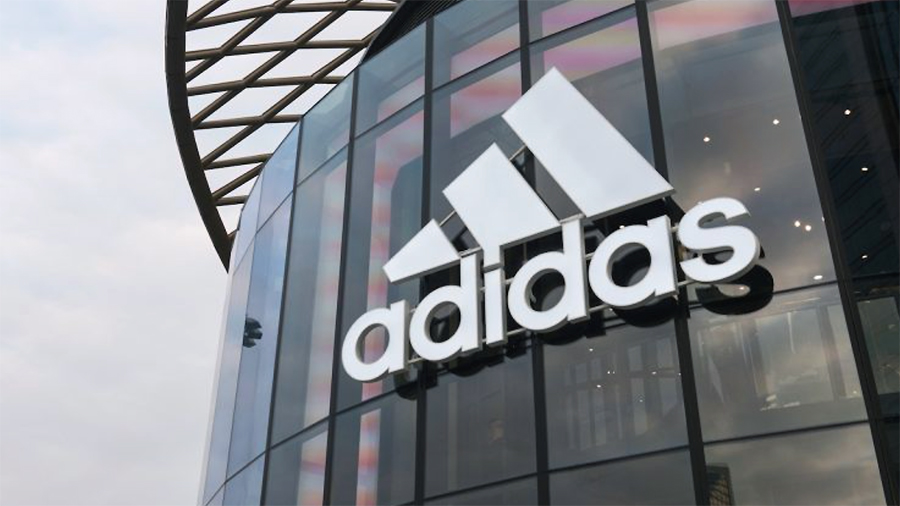Adidas said on Wednesday it would slash its dividend for 2023 and again warned it could suffer its first annual loss in 30 years as it deals with the fallout from its decision to split with rapper and fashion designer Kanye West. The company posted a major loss in the fourth quarter.
Adidas cut ties with West, known as Ye, in October following antisemitic comments by the rapper and workplace complaints against him. Analysts estimate Yeezy accounted for as much as 7 percent of total sales in its best years.
Adidas was left with £1.1 billion of unsold stock after reporting its annual results and is still deciding what to do with its stock of unsold Yeezy footwear.
The weak outlook also reflects continued macroeconomic challenges and geopolitical tensions, elevated recession risks in Europe and North America as well as uncertainty around the recovery in Greater China.
The results largely confirmed preliminary figures from the company’s profit warning in February.
Adidas’ new CEO Bjorn Gulden hopes the company can return to profitable growth by 2024 by reducing stocks and cutting discounts.
“2023 will be a transition year to build the base for 2024 and 2025,” said Gulden in a statement. “We need to reduce inventories and lower discounts. We can then start to build a profitable business again in 2024. Adidas has all the ingredients to be successful. But we need to put our focus back on our core: product, consumers, retail partners, and athletes. We will work on strengthening our people and the Adidas culture. Motivated people and a strong Adidas culture are the most important factors to build a unique Adidas business model again. A business model built to focus on serving our consumers through both wholesale and DTC, that balances global direction with local needs, that is fast and agile, and of course, always invests in sports and culture to keep building credibility and brand heat. Adidas is a fantastic brand, a fantastic company with great infrastructure and great talented people. We will bring it back to be the best sports brand in the world once again.”
Financial Performance In 2022
Currency-neutral sales grow 1 percent
In 2022, currency-neutral revenues grew 1 percent, reflecting increases in all market segments except Greater China. From a channel perspective, Adidas’ top-line development was supported by growth in both wholesale (+1 percent) and the company’s own direct-to-consumer (DTC) business (+2 percent). Within DTC, own retail revenues were flat compared to the prior year level. E-commerce revenues increased 4 percent during the year driven by double-digit growth in North America and Latin America. From a category perspective, currency-neutral revenues in Performance grew at a strong double-digit rate, while Lifestyle revenues declined. In euro terms, the company’s revenues increased 6 percent in 2022 to €22,511 million (2021: €21,234 million).
Revenue Growth In All Market Segments Except Greater China
From a market perspective, currency-neutral sales grew at a double-digit rate in Latin America (+44 percent) and North America (+12 percent). Revenues in EMEA were up 9 percent amid the significant adverse impact from the wind-down of the company’s business in Russia. Sales in Asia-Pacific grew 4 percent in 2022. In Greater China, revenues declined 36 percent compared to the prior year level due to the challenging market environment, company-specific challenges as well as significant inventory takebacks.
Gross Margin At 47.3 percent
The company’s gross margin decreased 3.4 percentage points to 47.3 percent in 2022 (2021: 50.7 percent). Broad-based price increases were more than offset by the strong increase in supply chain costs, reflecting increased product costs and freight expenses. In addition, higher discounts, particularly in the second half of the year, a less favorable market, category, and channel mix as well as negative currency developments weighed on the gross margin development in 2022. One-off costs in the amount of €59 million reflecting the company’s decision to wind down its business in Russia as well as higher provisions for customs-related risks also had an adverse impact on gross margin.
Operating Margin Decreases To 3.0 percent
Other operating expenses increased 15 percent to €10,260 million in 2022 (2021: €8,892 million). As a percentage of sales, other operating expenses were up 3.7 percentage points to 45.6 percent (2021: 41.9 percent). Marketing and point-of-sale expenses increased 8 percent to €2,763 million (2021: €2,547 million) as the company continued to invest in campaigns, such as ‘Run for the Oceans,’ ‘Stanniversary,’ and the Basketball campaign ‘Remember the Why.’ Further campaigns were launched around major sports events such as the 2022 Beijing Winter Olympics, the UEFA Women’s Euro 2022, and the FIFA World Cup Qatar 2022. In addition, Adidas invested in the launch of new products such as the X Speedportal football boot, the record-winning Adizero Adios Pro 3 running shoe, the Adidas x Gucci collection, and the federation kits for the FIFA World Cup Qatar 2022. Further enhancing the consumer experience across both its digital and physical platforms was another important part of Adidas’ marketing spend in 2022. As a percentage of sales, marketing and point-of-sale expenses increased 0.3 percentage points to 12.3 percent (2021: 12.0 percent). Operating overhead expenses increased 18 percent to €7,498 million (2021: €6,345 million), including €253 million of one-off costs related to the company’s decision to wind down its business in Russia, a settled legal dispute, as well as restructuring costs as part of the company’s business improvement program. As a percentage of sales, operating overhead expenses increased 3.4 percentage points to 33.3 percent (2021: 29.9 percent). As a result of the gross margin decrease, the increase in other operating expenses as a percentage of sales as well as the one-off costs of €312 million, the company’s operating profit decreased 66 percent to €669 million in 2022 (2021: €1,986 million). Consequently, the operating margin decreased 6.4 percentage points to 3.0 percent compared to the prior year’s level of 9.4 percent.
Net Financial Result Decreases
Financial income doubled to €39 million in 2022 (2021: €19 million). Financial expenses were up 110 percent to €320 million (2021: €153 million), mainly driven by increasing interest rates as well as currency effects. Net financial expenses were further impacted by one-off costs of €63 million related to cash-pooling in high inflationary countries. As a result, the company recorded a net financial result of negative €281 million (2021: negative €133 million). The company’s tax rate increased 15.0 percentage points to 34.5 percent in 2022, mainly driven by nondeductible expenses in Russia as well as by the derecognition of deferred tax assets (2021: 19.4 percent).
Net Income From Continuing Operations of €254 million
Net income from continuing operations decreased 83 percent to €254 million in 2022 (2021: €1,492 million). This decline was partly related to one-off costs in the amount of €350 million. These one-off costs reflect the company’s decision to wind down its business in Russia, a settled legal dispute, higher provisions for customs-related risks, cash-pooling in high inflationary countries as well as restructuring costs as part of the company’s business improvement program. Both basic and diluted EPS from continuing operations also decreased 83 percent to €1.25 (2021: €7.47).
Average Operating Working Capital at 24.0 percent of Sales
At the end of December 2022, inventories increased 49 percent to €5,973 million (2021: €4,009 million). The increase was mainly driven by higher product and freight costs, a different order pattern as a result of longer transportation lead times, the termination of the Yeezy partnership, as well as lower prior-year comparables due to last year’s impact from the factory lockdowns in Vietnam. On a currency-neutral basis, inventories also increased 49 percent. Accounts receivable increased 16 percent to €2,529 million at the end of December 2022 (2021: €2,175 million), reflecting the company’s strong growth in Western markets as well as lower prior year comparables due to last year’s impact from the factory lockdowns in Vietnam. On a currency-neutral basis, accounts receivable were also up 16 percent. Accounts payable increased 27 percent to €2,908 million at the end of December 2022 versus €2,294 million in 2021. This development mainly reflects higher sourcing volumes as well as higher product and freight costs. On a currency-neutral basis, accounts payable increased 27 percent. Average operating working capital as a percentage of sales increased 4.0 percentage points to 24.0 percent for the full year 2022 (2021: 20.0 percent).
Continuous Investments Into Stores and Digital
The company’s capital expenditure increased 4 percent in 2022 to €695 million (2021: €667 million). Investments in new or remodeled own retail or franchise stores as well as shop-in-shop presentations of Adidas products in customers’ stores represented almost half of the total. The remainder consisted mainly of investments in Digital/IT and logistics.
Executive and Supervisory Boards Propose Dividend Payment of €0.70 Per Share
The Adidas Executive and Supervisory Boards will recommend paying a dividend of €0.70 per dividend-entitled share to shareholders at the Annual General Meeting on May 11, 2023 (2022: €3.30). This reflects a payout ratio of 49.2 percent (2022: 40.9 percent) of net income from continuing operations and is at the upper end of the target range of between 30 percent and 50 percent of net income from continuing operations as defined in Adidas’ dividend policy.
Financial Performance in Q4 2022
Sales in the fourth quarter impacted by the decision to terminate Yeezy partnership
Currency-neutral revenues in the fourth quarter declined 1 percent. This development reflects the negative impact of around €600 million related to the company’s decision to terminate the Yeezy partnership at the end of October. In addition, a strong revenue decline in Greater China (-50 percent) due to the challenging market environment, company-specific challenges as well as significant inventory takebacks weighed on the company’s top-line development in the quarter. At the same time, revenues in Latin America (+47 percent), Asia-Pacific (+16 percent), and EMEA (+12 percent) grew at double-digit rates. Currency-neutral sales increased 6 percent in North America amid the discontinuation of the Yeezy partnership which had a particularly strong impact in this market. From a channel perspective, the company’s top-line development was driven by wholesale where currency-neutral revenues increased 4 percent. Revenues in the company’s own DTC channel declined 1 percent. While e-commerce revenues decreased 4 percent during the quarter, sales in Adidas’ own retail stores increased 1 percent. In euro terms, total Adidas revenues increased 1 percent versus the prior year to €5,205 million (2021: €5,137 million).
Gross Margin Decreased To 39.1 percent
In the fourth quarter of 2022, the gross margin declined by 9.9 percentage points to 39.1 percent (2021: 49.0 percent). This decline was driven by significantly higher supply chain costs as well as a strong increase in promotional activity. These developments could not be offset by price increases, positive currency developments and a positive channel and market mix.
Operating Loss Of €724 million
Other operating expenses were up 13 percent to €2,825 million during the fourth quarter (2021: €2,501 million). As a percentage of sales, other operating expenses increased 5.6 percentage points to 54.3 percent (2021: 48.7 percent). Marketing and point-of-sale expenses increased 7 percent to €767 million (2021: €715 million) and as a percentage of sales were up to 14.7 percent (2021: 13.9 percent). Operating overhead expenses increased 15 percent to €2,058 million (2021: €1,786 million). As a percentage of sales, operating overhead expenses increased to 39.5 percent (2021: 34.8 percent). As a result, Adidas recorded an operating loss of €724 million (2021: operating profit of €66 million), resulting in a negative operating margin of 13.9 percent (2021: positive operating margin of 1.3 percent). Net loss from continuing operations amounted to €482 million in the quarter including one-off costs of around €50 million mainly related to restructuring costs as part of the company’s business improvement program (2021: net income from continuing operations of €123 million). Both basic and diluted EPS from continuing operations were negative €2.69 in the fourth quarter of 2022 (2021: €0.58).
2023 Outlook
Underlying operating profit expected to be around the break-even level
In 2023, Adidas expects currency-neutral revenues to decline at a high-single-digit rate as macroeconomic challenges and geopolitical tensions persist. Elevated recession risks in Europe and North America as well as uncertainty around the recovery in Greater China continue to exist. The company’s revenue development will also be impacted by the initiatives to significantly reduce high inventory levels. In addition, while the company continues to review future options for the utilization of its Yeezy inventory, the guidance already reflects the revenue loss of around €1.2 billion from potentially not selling the existing stock. Accounting for the corresponding negative operating profit impact of around €500 million, the company’s underlying operating profit is projected to be around the break-even level in 2023.
Reported Operating Loss Of €700 Million Projected
Should the company irrevocably decide not to repurpose any of the existing Yeezy product going forward, this would result in the potential write-off of the existing Yeezy inventory and would lower the company’s operating profit by an additional €500 million this year. In addition, Adidas expects one-off costs of up to €200 million in 2023. These costs are part of a strategic review the company is currently conducting aimed at reigniting profitable growth as of 2024. If all these effects were to materialize, the company expects to report an operating loss of €700 million in 2023.















